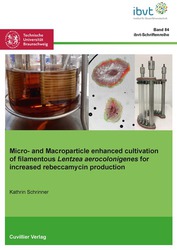| Fachbereiche | |
|---|---|
| Buchreihen (96) |
1378
|
| Nachhaltigkeit |
3
|
| Gesundheitswesen |
1
|
| Geisteswissenschaften |
2364
|
| Naturwissenschaften |
5406
|
| Mathematik | 229 |
| Informatik | 319 |
| Physik | 980 |
| Chemie | 1363 |
| Geowissenschaften | 131 |
| Humanmedizin | 243 |
| Zahn-, Mund- und Kieferheilkunde | 10 |
| Veterinärmedizin | 108 |
| Pharmazie | 147 |
| Biologie | 835 |
| Biochemie, Molekularbiologie, Gentechnologie | 121 |
| Biophysik | 25 |
| Ernährungs- und Haushaltswissenschaften | 45 |
| Land- und Agrarwissenschaften | 1004 |
| Forstwissenschaften | 201 |
| Gartenbauwissenschaft | 20 |
| Umweltforschung, Ökologie und Landespflege | 148 |
| Ingenieurwissenschaften |
1793
|
| Allgemein |
98
|
|
Leitlinien Unfallchirurgie
5. Auflage bestellen |
|
Erweiterte Suche
Micro- and Macroparticle enhanced cultivation of filamentous Lentzea aerocolonigenes for increased rebeccamycin production (Band 84)
Kathrin Schrinner (Autor)Vorschau
Leseprobe, PDF (930 KB)
Inhaltsverzeichnis, PDF (130 KB)
The filamentous actinomycete Lentzea aerocolonigenes produces the antitumor antibiotic rebeccamycin. However, the complex morphology of actinomycetes leads to challenges during the cultivation often accompanied by low product titers. In the recent past, the to date low rebeccamycin titers were increased by particle addition to cultivations of L. aerocolonigenes. In this thesis the addition of micro-, macro- and adsorbent particles to cultivations of L. aerocolonigenes were investigated in more detail. Furthermore, the scale-up to a bubble-free bioreactor was conducted.
The addition of glass microparticles (x50 = 7.9 μm, 10 g L-1) to shake flask cultivations increased the rebeccamycin titer up to 3.6-fold compared to an unsupplemented approach. Pellet slices showed the incorporation of microparticles. With different surface modifications of the microparticles, specific incorporation patterns of the microparticles appeared. The incorporation of microparticles causes looser and smaller pellets allowing an increased nutrient and oxygen supply in the pellet core. With addition of larger (glass) macroparticles (ø = 0.2 – 2.1 mm, 100 g L-1) mechanical stress was induced on the biopellets. The additional supplementation of 5 g L-1 soy lecithin and glass beads (ø = 969 μm, 100 g L-1) resulted in a rebeccamycin titer of 388 mg L-1, one of the highest rebeccamycin titers ever achieved. For the scale-up of L. aerocolonigenes cultivations a bubble-free membrane aeration system was developed. The tubular membrane aeration system can additionally be pressurized to increase the oxygen transfer. First cultivations of L. aerocolonigenes successfully provided 18 mg L-1 rebeccamycin, a concentration similar to that of unsupplemented shake flask cultivations. XAD adsorbent particles were added to cultivations to facilitate rebeccamycin recovery. However, the XAD particles additionally increased the rebeccamycin titer which was likely to be caused by the adsorption of the rebeccamycin precursor tryptophan to the resins which in turn directly transferred the tryptophan to the microorganism.
| ISBN-13 (Printausgabe) | 9783736973503 |
| ISBN-13 (E-Book) | 9783736963504 |
| Buchendformat | A5 |
| Sprache | Englisch |
| Seitenanzahl | 142 |
| Umschlagkaschierung | matt |
| Auflage | 1 |
| Buchreihe | Schriftenreihe des Institutes für Bioverfahrenstechnik der Technischen Universität Braunschweig |
| Band | 84 |
| Erscheinungsort | Göttingen |
| Promotionsort | Braunschweig |
| Erscheinungsdatum | 05.01.2021 |
| Allgemeine Einordnung | Dissertation |
| Fachbereiche |
Mikrobiologie und Biotechnologie
|
| Schlagwörter | Actinomycete, Bioprocess optimization, Bubble-free membrane aeration, Cell morphology, Filamentous microorganisms, Flow cytometry, Image analysis, In-situ product recovery, Lentzea aerocolonigenes, Macroparticle-enhanced cultivation, Membrane aerated stirred bioreactor, Mechanical stress, Microparticle-enhanced cultivation, Morphology Engineering, Pellets, Pellet slicing, Pellet viability, Rebeccamycin, XAD adsorbent resins, Actinomyceten, Bioprozessoptimierung, blasenfreie Membranbegasung, Zellmorphologie, Filamentöse Mikroorganismen, Durchflusszytometrie, Bildanalyse, In-situ Produktrückgewinnung, Lentzea aerocolonigenes, Makropartikelunterstütze Kultivierung, membranbegaster Rührbioreaktor, Mechanische Beanspruchung, Morphologiebeeinflussung, Pellets, Pelletschnitte, Pelletviabilität, Rebeccamycin, XAD Adsorberharze, Bioprozess, blasenfrei, Granulat,Produkttiter |








